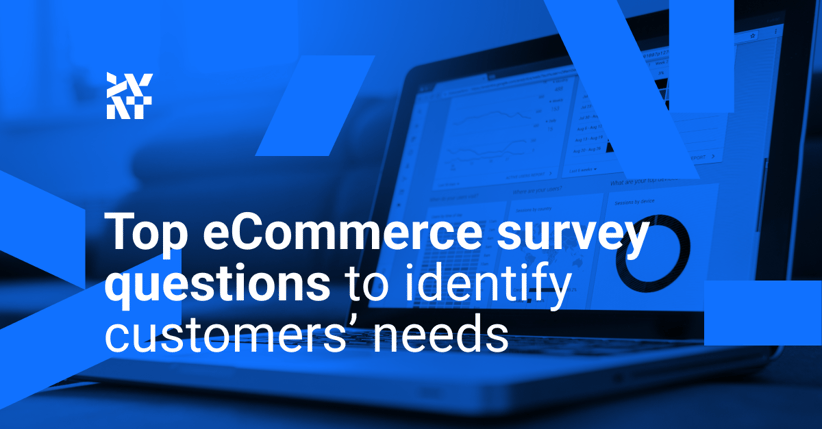As we all know, improving the eCommerce customer experience means addressing your buyers’ needs. Creating and sending out a survey is a solid strategy for learning more about your customers.
But generating meaningful survey results requires efficiency and the right questions. So, what should you be asking? Here we’ll explore the best questions to get the answers you need.
Types of eCommerce survey questions
The first thing to think about is which stage of the customer journey you need feedback about. Identify the interactions you want to target to glean the most valuable information.
This might include:
Pre-purchase
These questions focus on users in the consideration phase who are likely to be first-time visitors to your landing, product, and information pages. Key questions to ask in the pre-purchase stage relate to your audience’s concerns, preferences, and potential fears.
The information you receive will help you understand what visitors expect to find on your website. Once you know this, you can pivot your existing content to address their concerns and move them from the consideration to the attention phase.
Questions not to ask during the pre-purchase stage include:
- What brings you to our website today?
- What is your first impression of our brand?
Both of these questions are overly generic, and neither will help you achieve your goal of meaningful eCommerce analytics.
 Free-to-use image from Pixabay
Free-to-use image from Pixabay
Imagine the answers you might receive to these questions:
- What brings you to our website today? “I want to shop online for clothes.”
- What is your first impression of our brand? “It’s fine.”
Neither of these answers tells you anything at all. Skip these questions, and instead consider asking:
What problems are you hoping to solve with our products?
This question is ideal for low conversion rate pages and will help you better understand your potential customers’ pain points.
When you know what their common problems are, you can create and optimize content accordingly to address these and deliver reassurance. Similar to creating an IVR menu for a business phone, the overall goal is to make it as simple as possible for users to get to where they want to go.
For example, say you run a dog accessories eCommerce site.
A possible answer to this question: “I struggle to dry my dog after a walk and need a quick solution.”
You might discover that a frequent pain point for dog owners is struggling to get their dogs dry quickly after a walk. Delve a little deeper into this, and you can assume that morning walks when they’re rushing to get ready for work is a particular issue.
To address this very specific pain point, you should optimize your website’s landing pages to deliver your solution, such as a rapid dry dog towel. Focus on pertinent features, such as “This towel guarantees a less than 60-second drying time from start to finish.”
Don’t forget to amend product meta descriptions to aid SEO. You could also consider creating a blog around the topic and mention other inferior dog towels in it. This action elevates the customer experience and positions your brand as a market leader.
Post-purchase
Post-purchase survey questions must be simple and straightforward. They should reveal what you need to improve about the overall buying experience and any potential blockers to purchasing. The data you receive will help you to include more strategic CTAs and understand more about how users navigate your eCommerce site so you can eliminate friction.
Questions not to ask in the post-purchase stage include:
- Did you have a stress-free shopping experience with us?
- How can we better serve you next time?
As with the pre-purchase questions from before, neither of these questions tells you much. There are better ways to find out the information you need.
Imagine the sort of answers you might receive to these questions:
- Did you have a stress-free shopping experience with us? “Yes/No.”
- How can we better serve you next time? N/A
This second question might frequently go unanswered because the customer can’t think of anything to say. After all, it’s not their job to solve problems for you. So, you can either conclude that nothing can be improved or assume something can but be no further on with identifying it.
 Free-to-use image from Unsplash
Free-to-use image from Unsplash
Instead, consider asking:
What almost stopped you from completing your checkout?
Then provide a list of multiple-choice answers, such as:
- High shipping costs
- Slow website speed
- Preferred payment option not available
- Other (please specify)
You managed to get the sale, so that’s great, but understanding what almost prevented it is valuable data. It will help you improve your service and develop a better and more user-friendly eCommerce website.
Exit-intent
Establishing the reasons why users don’t turn into customers is just as important. Exit-intent survey questions help you discover why people abandoned your website.
This could be for any number of reasons, so focus your questions around specific areas that you think might be problems. Then, take steps to optimize your product pages to retarget those users.
For example, if you think your customers need to know about, "What is VoIP?” you can create valuable content to pre-empt their questions and show you understand their needs.
Questions not to ask during the exit-intent stage:
- Did something go wrong on our website?
- Do you need any additional information or support to complete your order?
Neither of these questions encourages information. Chances are, you’ll simply get a “Yes/No” response, which doesn’t help you.
Instead, consider asking:
What can we improve about our checkout process?
Provide the respondent with various options, such as:
- Lower your shipping costs
- Make it clear where to go next
- Make your website less glitchy/faster
- Offer more payment options, such as:
- PayPal
- Pay in installments
- American Express
- Other
- Other (please specify)
 Free-to-use image from Unsplash
Free-to-use image from Unsplash
More top eCommerce survey questions
Hopefully, these explanatory questions have piqued your interest in creating effective eCommerce surveys.
If you’re just starting an eCommerce business, other questions to help you gain useful insights include:
- How likely are you to come back and make a purchase with us?
- Are any of your favorite products out of stock? (Then ask them which.)
- Did we offer your preferred payment method? If not, please tell us your preference.
- What is your primary reason for purchasing with us over our competitors’? (Include drop-down options for answering.)
How often should you send out eCommerce surveys?
According to Qualtrics, “For B2C, a good rule of thumb is to base your survey frequency on how often customers interact with you and multiply it by two. So if they interact with you monthly, send your survey every two months. If they interact with you weekly, send it every two weeks”.
However, transactional surveys, like post-eCommerce purchase questions, are an exception and can be sent after every transaction. If you take this approach, the frequency of your surveys means your questions need to be low effort, so stick to a maximum of four questions to avoid survey fatigue in your customers.
Key takeaways
Like high-converting email forms, improving your business and customer experience is within your grasp. You just need a well-designed eCommerce survey to help you do it.
Incorporating changes based on customer feedback will show buyers you’re responsive to their views and opinions and should also enhance your product offerings. Remember, when you’re creating eCommerce survey questions, be sure to:
- Avoid asking generic and open-ended questions that don’t provide useful information.
- Consider your audience and adjust your survey frequency accordingly.
- Create simple but impactful questions that help uncover common pain points.
 |
Grace Lau is the Director of Growth Content at Dialpad and AI-powered cloud communication platform for better and easier team collaboration using Dialpad toll-free numbers for business. She has over 10 years of experience in content writing and strategy. Currently, she is responsible for leading branded and editorial content strategies, partnering with SEO and Ops teams to build and nurture content. Here is her LinkedIn. |
Published April 26, 2023











